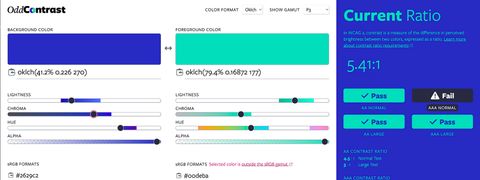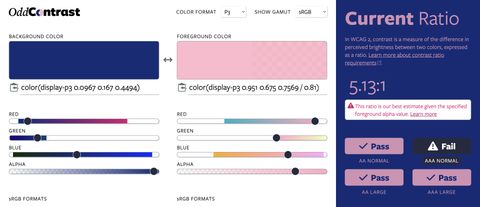Make the Web a More Colorful Place!
A guide to using new color spaces & formats with OddContrast
OddBird’s color tool not only checks contrast ratios, but supports the new CSS color formats and spaces.

We explore the useful testing capabilities provided by FastAPI and pytest, and how to leverage them to produce a complete and reliable test suite for your application.
This article is part of our ongoing series on FastAPI:
Check out our Winging It conversations about design, frontend, and backend development.
Winging It episode 5: Streamline Your API Development with FastAPI
Testing is an integral part of the development process, as it ensures the functionality, stability, and overall quality of the codebase. In this article, we will explore several topics related to testing FastAPI applications. By the end, you will have a solid understanding of how to effectively test your FastAPI applications, giving you the confidence to add new features, refactor code, and squash bugs.
When testing API endpoints, we want to follow this basic structure:
FastAPI provides a test client that makes it easy to make requests to our
application without needing to run a server, and we can use Python’s built-in
assert statement to verify the response.
# File: test_api.py
from fastapi.testclient import TestClient
from app.main import app # The application with all your endpoints
client = TestClient(app)
def test_root():
response = client.get("/")
assert response.status_code == 200The recommended way to run tests is to use the pytest testing framework.
After installing it with pip install pytest, you can run your tests with the
pytest command.
$ pytestPytest will collect all files that match the test_*.py or *_test.py pattern,
and execute all methods and functions that match the test_* pattern. Then it
will report the status of each test (pass, fail, or error).
Pytest fixtures are one of its most powerful features. I encourage you to read the official documentation to get acquainted with this excellent tool, but for the purposes of this article we can define them as so:
conftest.py and decorated with
@pytest.fixtureWhy are fixtures so useful? Because they let us abstract out complex setup and teardown logic for our tests. We can use the results of these processes by simply adding an argument to our test function. For example, we can define a fixture that creates test data for us, instead of having to manually create it in each test.
# File: conftest.py
import pytest
from app.models import Fruit
@pytest.fixture
def fruit_collection():
return [
Fruit("apple"),
Fruit("banana"),
Fruit("cherry"),
]All of our tests can use the fruit_collection fixture to get a list of fruits
to test against:
# File: test_api.py
from app import make_pie, make_smoothie
def test_pies(fruit_collection):
pies = make_pie(fruit_collection)
assert pies == ... # Some assertion about the `make_pie` function
def test_smoothies(fruit_collection):
smoothies = make_smoothie(fruit_collection)
assert smoothies == ... # Some assertion about the `make_smoothie` functionNotice we don’t need to import or call the fixture; we get the return value (a
list of Fruit instances) by adding a parameter to our tests. This is a simple
example, but in the next sections we will see how to use fixtures to factor out
complex setup logic for our FastAPI tests.
I consider it a best practice to use a real database when testing, instead of using mocks or “light” databases. My goal is to test the application as close to production as possible, and if the test suite doesn’t catch a bug related to the database implementation, it doesn’t give me much confidence to add new features or refactor. At the same time, I want to make sure that tests execute in isolation from each other and without worrying about the state of the database before and after the test runs. Fixtures are the perfect tool to achieve this.
First, let’s make sure we have a database to test against:
# File: conftest.py
import pytest
from urllib.parse import urlparse
from sqlalchemy import create_engine
from app.models import Base
from app import settings
@pytest.fixture(scope="session")
def engine():
"""
Create the test database (if needed) and engine
"""
test_db_name = "test_app"
db_url = urlparse(str(settings.DATABASE_URL))
test_engine = create_engine(db_url._replace(path=f"/{test_db_name}").geturl())
try:
Base.metadata.drop_all(bind=test_engine)
except OperationalError as err:
if f'database "{test_db_name}" does not exist' not in str(err):
raise
root_db_url = db_url._replace(path="/postgres").geturl()
conn = create_engine(root_db_url, isolation_level="AUTOCOMMIT").connect()
conn.execute(sa.text(f"CREATE DATABASE {test_db_name}"))
conn.close()
finally:
Base.metadata.create_all(bind=test_engine)
return test_engineThis fixture is scoped to the test "session", which means it will be
automatically created once and shared across all tests. We start by obtaining a
db_url from our application settings, which contains the credentials to
connect to the database engine. We then create a new SQLAlchemy engine with the
same credentials, but with a different database name defined in test_db_name.
Because the database will not be deleted after each test run, we try to drop
all tables now. In CI environments the database will not exist at all, so we
make sure to execute a CREATE DATABASE in those cases. Finally, we create all
the tables in the test database. We now have an isolated database for our tests!
Let’s review our application code to figure out how to insert this new engine:
# File: app/main.py
from fastapi import FastAPI, Depends
from sqlalchemy import create_engine
from sqlalchemy.orm import sessionmaker
from app import settings
app = FastAPI()
engine = create_engine(settings.DATABASE_URL)
SessionLocal = sessionmaker(autocommit=False, autoflush=False, bind=engine)
def get_db():
db = SessionLocal()
try:
yield db
finally:
db.close()
@app.get("/")
def my_endpoint(db: Session = Depends(get_db)):
return db.query(...).all()Notice the chain of dependencies starting from the my_endpoint function:
my_endpoint uses a db parameter provided by get_db (wrapped in
Depends).get_db yields from SessionLocal.SessionLocal is bound to the engine we created.engine is created from the DATABASE_URL in our settings.We can try to be clever and monkey-patch the settings or the functions provided
by SQLAlchemy, but FastAPI actually provides a better way to do this:
dependency overrides. Basically, we can replace any function or class that
uses Depends with a different implementation.
Let’s create a new fixture that will automatically inject itself in place of the
get_db function:
# File: conftest.py
from app.main import app, get_db
@pytest.fixture(autouse=True)
def db(engine: sa.engine.Engine):
"""
Provides a DB session that will roll back after the test is complete to ensure clean
tables for each test. See: https://stackoverflow.com/a/67348153
"""
connection = engine.connect()
transaction = connection.begin()
session = Session(autocommit=False, autoflush=False, bind=connection)
# Begin a nested transaction (using SAVEPOINT)
nested = connection.begin_nested()
# If the application code calls `session.commit`, it will end the nested
# transaction. We need to start a new one when that happens.
@sa.event.listens_for(session, "after_transaction_end")
def end_savepoint(session, transaction):
nonlocal nested
if not nested.is_active:
nested = connection.begin_nested()
app.dependency_overrides[get_db] = lambda: session
yield session
del app.dependency_overrides[get_db]
# Rollback the overall transaction, restoring the state before the test ran
session.close()
transaction.rollback()
connection.close()This fixture has the autouse flag, which means it will be automatically used
by all tests. Because the scope is not set, the fixture will run for each
individual test function. The fixture creates a new connection to the database
using the engine from the previous fixture and ensures all changes are rolled
back after the test is complete. The actual override of our application happens
in this line:
app.dependency_overrides[get_db] = lambda: sessionThis tells FastAPI to use the session object instead of the real get_db
function when resolving the db parameter in our endpoint. Now all endpoints
that use get_db will use our automatically rolled-back session instead of the
real database, giving us predictable and isolated tests.
You will notice that this fixture uses yield session instead of return session. This is because we want to run some code after the test is complete,
and yield allows us to do that. The yield statement is where the test
function will receive the session object, and the code after the yield
statement will run after the test is complete. In this case we make sure to
remove the override and close the connection to the database.
Because the db fixture is auto-used, we don’t need to add it to our test
functions. However, we can add it explicitly to assert the application state
after making requests to our endpoints:
# File: test_api.py
from app.models import Item
def test_add_item(db):
response = client.post("/add-item", json={"name": "Item 1"})
assert response.status_code == 200
item = db.scalars(select(Item)).one()
assert item.name == "Item 1"The db fixture allows us to make queries in the context of the test
transaction, and is automatically rolled back after the test is complete. You
can also use it in other fixtures to create test data:
# File: conftest.py
@pytest.fixture
def item(db):
item = Item()
db.add(item)
db.commit()
return itemNow we can use the item fixture in our tests to get an instance of Item that
is automatically rolled back after the test is complete:
# File: test_api.py
def test_update_item(db, item):
response = client.post(f"/items/{item.id}", json={"name": "Item 2"})
assert response.status_code == 200
db.refresh(item)
assert item.name == "Item 2"We can create a fixture to get instances of the test client for our tests:
# File: conftest.py
from fastapi.testclient import TestClient
from app.main import app
@pytest.fixture
def anon_client():
return TestClient(app)We can then use this fixture in our tests to make anonymous requests to our application:
# File: test_api.py
def test_root(anon_client):
response = anon_client.get("/")
assert response.status_code == 200But what if we need to test endpoints that require authentication? We can create a new fixture that creates a user and an access token and injects them into the client:
# File: conftest.py
from fastapi.testclient import TestClient
from app.main import app
# These functions are defined somewhere in the application code
from app.auth import create_access_token, create_user
@pytest.fixture
def client(db):
user = create_user(db)
token = create_access_token(user)
client = TestClient(app)
client.user = user
client.headers["Authorization"] = f"Bearer {token}"
return clientclient.user = user is a convenience to access the user instance in tests. It’s
useful to make assertions about the user’s state after making requests to the
application:
# File: test_api.py
def test_user_name(client):
response = client.get("/user")
assert response.status_code == 200
assert response.json()["name"] == client.user.nameNow we can use the client fixture in our tests to make requests to our
application with a user that is authenticated. Assuming our application checks
for tokens in the Authorization header, we can now test our authenticated
endpoints:
# File: test_api.py
def test_protected_endpoint(client):
response = client.get("/protected")
assert response.status_code == 200Alternatively, if we were to use a different transport for authentication, we can update the fixture to use the appropriate headers or cookies. Here’s an example that uses fastapi-users with cookies:
# File: conftest.py
from fastapi.testclient import TestClient
from app.main import app
# These functions are defined somewhere in the application code
from app.auth import create_access_token, create_user
@pytest.fixture
def client(db):
user = create_user(db)
token = create_access_token(user)
client = TestClient(app)
client.user = user
client.cookies.set(
"fastapiusersauth", token, domain="testserver.local", path="/"
)
return clientIn this case we are setting client.cookies instead of client.headers. The
point is that our client fixture can modify the built-in client in whatever
way is necessary to make authenticated requests to our application, or comply
with any other requirements we have for our tests.
By following the techniques outlined in this article, you can ensure the robustness and correctness of your FastAPI application by testing it in a way that closely resembles its behavior in production. These techniques also ensure your test suite is not fragile and behaves in a predictable manner, leveraging the powerful testing capabilities provided by FastAPI and pytest.
To further explore testing in FastAPI applications, we recommend referring to
the FastAPI testing tutorial and the pytest documentation for in-depth
explanations and additional examples.

A guide to using new color spaces & formats with OddContrast
OddBird’s color tool not only checks contrast ratios, but supports the new CSS color formats and spaces.

hint popovers, position-area and more
We have been busy updating the Popover and CSS Anchor Positioning Polyfills, but there is still more we can do with your help.

Display color gamut ranges and more
OddContrast, OddBird’s color format converter and contrast checker, gets new features – including the ability to swap background and foreground colors, and display color gamut ranges on the color sliders. Contrast ratios now incorporate foreground color alpha values.